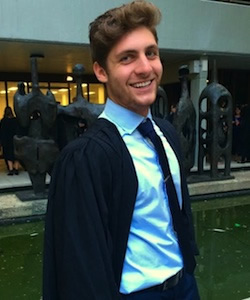The day I arrived in Sydney was one of the only days I’ve seen rain here in Australia. After passing the final airport checkpoint—where my bags were sniffed by a big black Labrador retriever—I met up with a terse, tired cluster of international students waiting for their first shuttle to campus. Led by a remarkably chipper university upperclassman, we slowly made our way to a van and began a real life game of Tetris in an effort to fit something like two dozen huge suitcases into the trunk. Jolting along on the left side of the road trying to keep the mountain of luggage obscuring the rearview from tumbling down into the backseats, we passed a number of flashing orange signs. Digital type, orange dots lighting up a road sign that read: “LOCKOUT PROTESTS 2-5 PM ROADS CLOSED.”
The upperclassman driving the van was on the phone, planning a party, but he mentioned the signs to his friend. After hanging up he turned to us. “You must not know about the lockout laws, right? No? Let me explain it to you.”
Since that first day lurching toward campus for the first time I’ve heard countless variations of the story. The various perspectives range from an interpretation of the laws as rational lawmaking to one that involves a full-blown conspiracy theory. The truth, as it always seems to be, is probably somewhere in between, but what is for certain is that the lockout laws are one of the most controversial issues in Sydney. In the past few months alone the efforts to repeal them have escalated to include a number of fierce debates, politically charged graffiti, and protests with attendance numbering in the tens of thousands.
The events that spurred the lockout laws occurred in relatively quick succession in King’s Cross, the closest neighborhood Sydney has to a red-light district. On July 7, 2012 18-year-old Thomas Kelly was, for no reason and without notice, punched in the head while walking with his girlfriend and talking on his cell phone. As well as inflicting severe injuries, the punch left him unconscious, and he was taken off life support within two days. The second incident resulted in the death of Daniel Christie, who was punched on December 31, 2013, while on a street with another teenager, his brother. Christie's life support was ceased after 11 days.
In the months following each of these attacks the New South Wales television networks enacted something resembling a media blitzkrieg. Through constant, inescapable coverage, news anchors and politicians alike embraced a transformation of the events—that is, two gruesome, albeit isolated deaths—into what they termed an “epidemic” of drug and alcohol-fueled violence. Such intense criticism led to a rise in pressure for the New South Wales government to take action, and by January 2014 the nefarious “lockout laws” were in place.
The laws themselves amount to a crackdown on Sydney’s nightlife. Sentencing minimums skyrocket, fines increase, and police are now able to identify and immediately ban “troublemakers.” But the most loathed part of the laws is the time restrictions. Within the new Sydney Central Business District Entertainment Precinct, venues will be unable to let in new patrons after 1:30 a.m., and drinks stop being served at 3:00 a.m. This means that if you’re not somewhere by 1:30, you’re can’t get in anywhere. If you’re lucky enough to be in a club, the night is over the second you step outside.
It is difficult to grasp the extent to which the laws, which were immediately met with a tidal wave of criticism, have affected Sydney’s nightlife. At a basic level, because of the 1:30 lockouts, people are more or less forced to go to one establishment, so the amount of foot traffic between venues has decreased significantly. With the crowds dying down by 2:30, clubs began to close earlier and earlier, eventually laying off staff members. DJs, bartenders, even bar-backs and bouncers—all these parties are affected. But it’s not just jobs that have been lost. In the last year alone over a dozen historic bars and clubs have shut down completely, owing to a heavy loss in proceeds due exclusively to the lockout laws.
One aspect of the laws is undeniably hypocritical. Notably, the city’s only casino, the massive Star Sydney in Pyrmont, as well as the Crown Sydney, an extravagant six star casino and hotel resort that is currently pending planning approval for construction, are both exempt. Small bars, casinos, restaurants, and tourist accommodation facilities can also dodge the laws, though whether or not they make the cut is somewhat arbitrary. Taken together with the fact that many of the recently shut down bars and clubs have quickly been bought up to serve as future residential spaces, apartments, and townhouses, a picture begins to emerge. Perhaps these are not entirely benevolent laws. Perhaps there is machinery at work outside the purview of the public.
The chain reaction involving the laws themselves isn’t even the most interesting part of the story. What’s truly fascinating is instead how swiftly the New South Wales government moved to enact legislation knowing it would have such a critical impact on so many businesses in the city. In the last year alone the laws have acted as a quick death knell to many bars, clubs, and other nightlife spots, and the number of casualties is rising. The level of drug- and alcohol-fueled violence, on the other hand, has barely budged, and this, some critics say, is only because there is no longer anyone on the streets past the now infamous hours.
Ultimately, the laws bring into question the power of the state in Sydney. Should the government be able to mandate when private businesses are allowed to operate? Does the government have the right to mettle with the affairs of bars and clubs in a purely detrimental way, robbing the vast swath of an entire industry of their jobs and effectively destroying the city’s nightlife?

